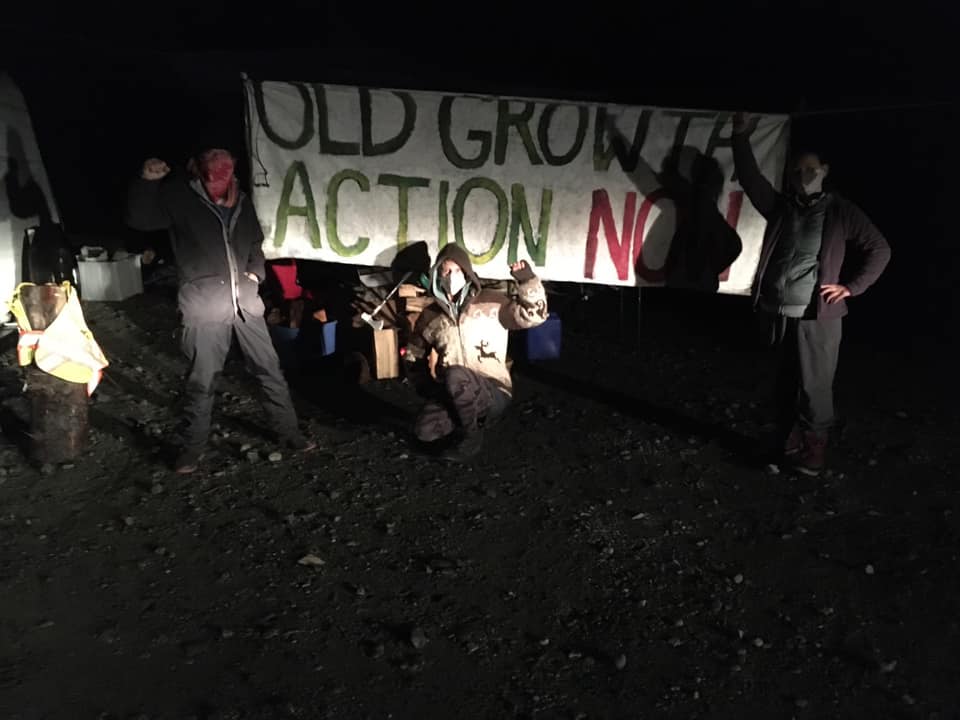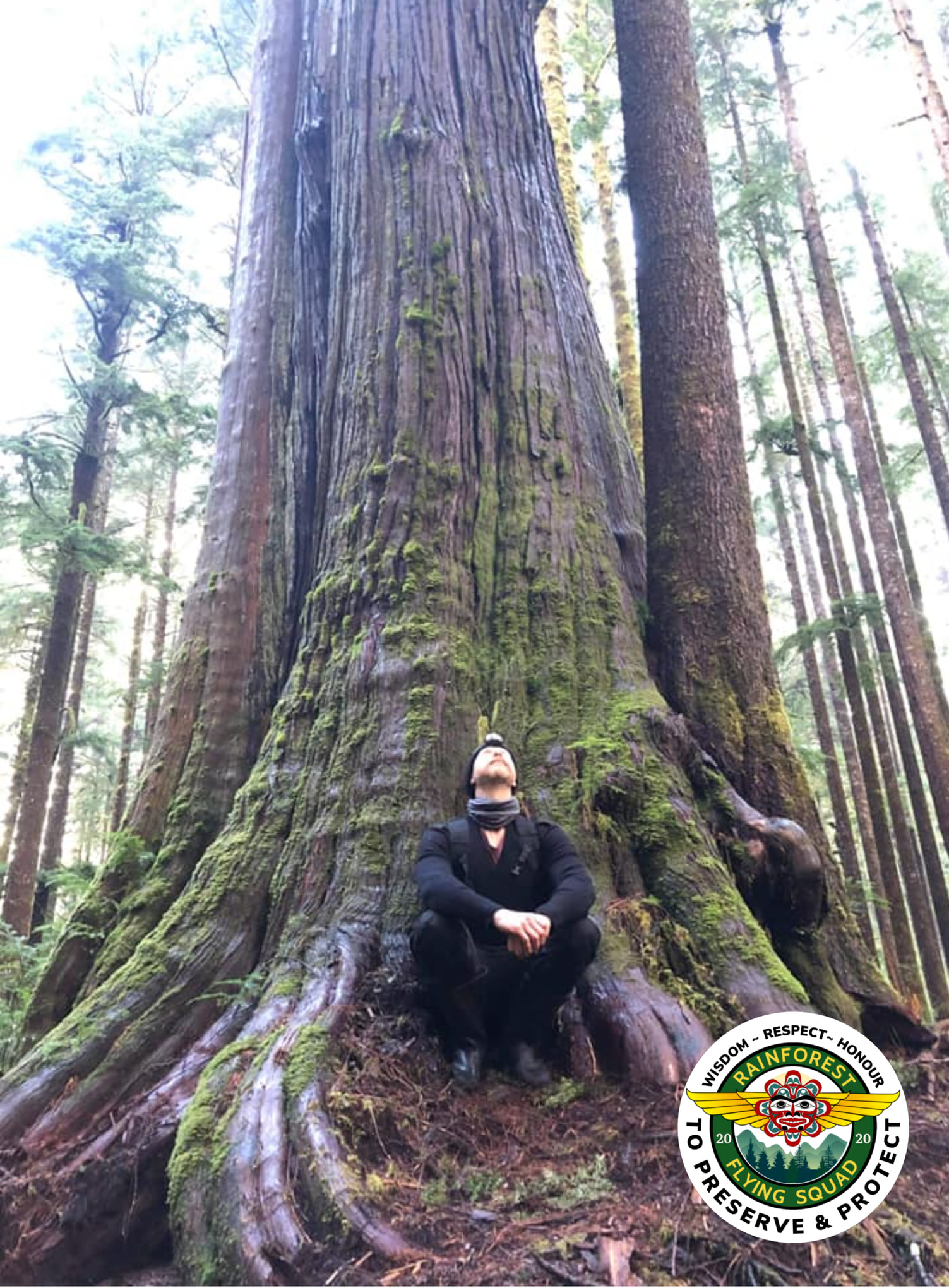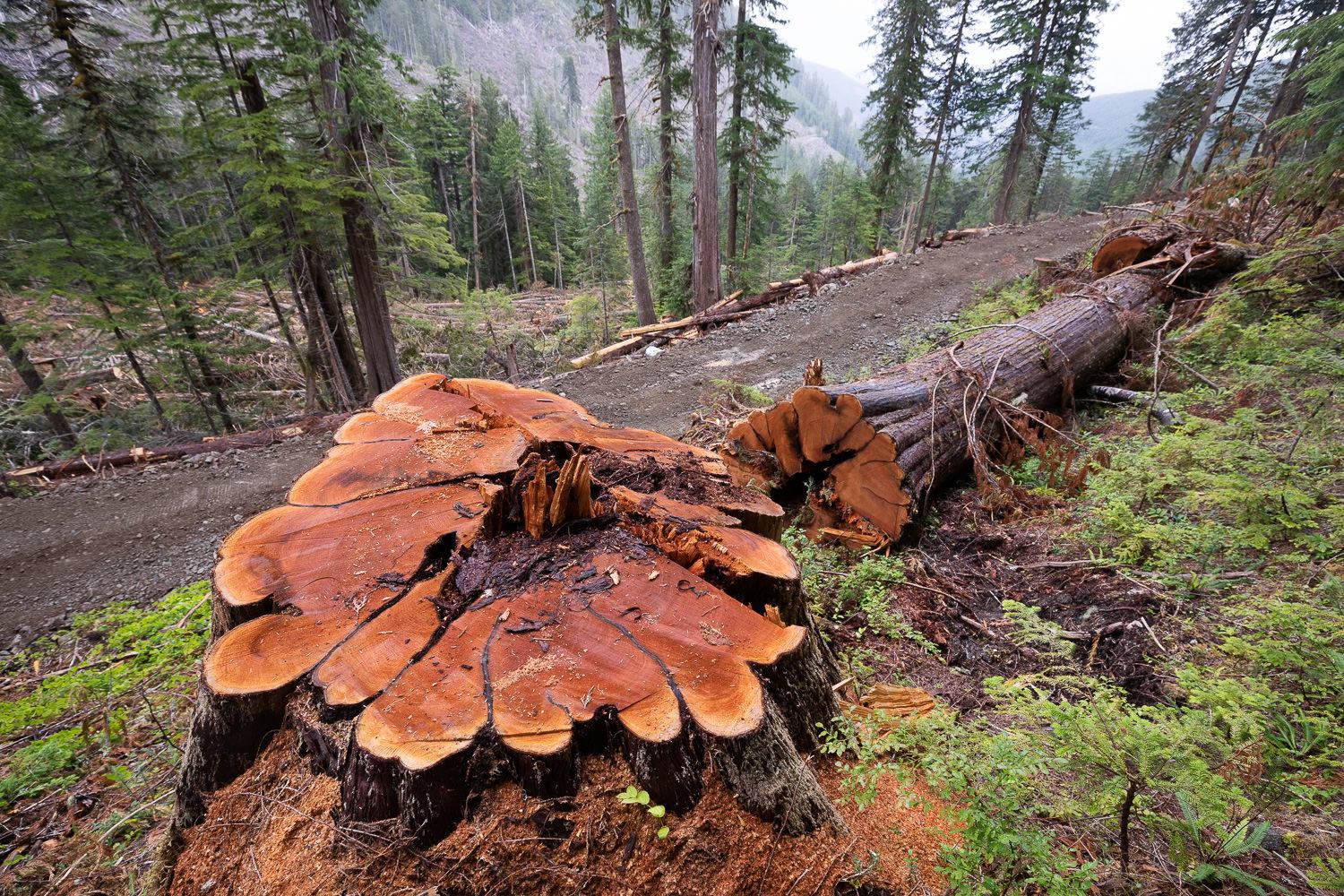
by DGR News Service | Aug 25, 2020 | Biodiversity & Habitat Destruction, Direct Action
A third blockade has started to stop the logging of near the headwaters of Fairy Creek. To learn more about the blockade in Fairy Creek, read the media release by the organizers of the blockade, and listen to interviews with Joshua Wright here and here. Access the official Facebook page here.
Two weeks into a campaign to halt logging of ancient rainforests in the last intact watershed of the San Juan River system, activists have set up a third blockade on unceded Pacheedaht territory!
Grassroots forest defenders from across Vancouver Island have successfully prevented Teal Jones Group from blasting logging roads into the unlogged headwaters of the Fairy Creek watershed for the past two weeks.
The first blockade was established on Monday, August 10th, where the new roads were about to crest a ridge into the west side of the watershed. The blockaders successfully turned away the road builders early that morning. Teal Jones removed their road building equipment on Tuesday, August 11th, and the blockade has remained in place continuously since then.
On August 17th, in light of government inaction to meet the blockaders demands, a second blockade was established just to the east of the Fairy Creek watershed, preventing Teal Jones from building roads which have been approved for construction into that side of the rainforest, located on unceded Pacheedaht Territory.
And on the evening of August 23rd, a third blockade was established. The third blockade is located on a logging road on Edinburgh mountain (also unceded Pacheedaht Territory). With the exception of Eden Grove on Edinburgh mountain, contiguous old-growth corridors have been severed between the rich valley bottom and the protected upper reaches. The infamous Big Lonely Doug stands in stark contrast to clear cut in a cutblock on Edinburgh, the sole remaining giant fir in the cut. Lonely Doug has become an internationally recognized symbol for BC’s devastating logging practices. Just up the mountain, logging is ongoing. This is what the newest blockade will stop.

Photo shows Teal Jones old-growth logging operations adjacent to Fairy Creek. Photo by Ancient Forest Alliance.
This new blockade also obstructs old growth logging already in progress east of Fairy Creek.
This stretch of ancient forest is contiguous with the intact old growth forest within the Fairy Creek watershed and contains high value valley bottom old growth forest that would be fully eradicated if the logging was allowed to continue. A massive, ancient cedar recently felled by Teal Jones in one of the old growth cut blocks now being blockaded:
“If anyone has ever felt called in their heart to take a stand for old growth forests, we invite them to join us here in Premier John Horgan’s own electoral riding: at our first blockade, or at this new, more easily accessible second blockade,” stated Cowichan Valley resident Caimen Shapiro.
Teal Jones, the licence holder of TFL 46, over the past month has begun road construction in the old growth hotspot of Fairy Creek that would enable them to clear-cut the upper Fairy Creek watershed, near Port Renfrew. The company has felled and graded several hectares of old growth forest on a road network that, had it not been for our first blockade, would have breached the ridgeline and entered the watershed.
Protection of Old Growth Forests
In view of the forthcoming release of theOld Growth Strategic Review (OGSR) report and recommendations, being held up by the BC government for up to 6 months from early May, with no firm release date to the public, we are again asking the Premier to establish:
1. The immediate and permanent protection of the entire Fairy Creek Valley, thereby nullifying all cut blocks and road construction approvals in the watershed and contiguous old growth forests. We demand this take place without a ‘land swap’ that would remove protections from other old growth forests to compensate Teal Jones.
2. An immediate end to old growth logging on Vancouver Island.
In an article in The Narwhal, Jan. 27, 2020, Gary Merkel, one of the two commissioners of the OGSR states: “I think the thing that surprised me the most is the degree of unanimity and common thinking around ‘we need to get back to the land’ and about moving past political cycles … we’re hearing it from almost everywhere,” Merkel told The Narwhal in a joint phone interview with Gorley: “We’re managing ecosystems — that are in some cases thousands of years old — on a four-year political cycle. The management systems change from government to government,” said Merkel, the former chair of both the Tahltan Nation Development Corporation and the Columbia Basin Trust.
We are now at the stage of final eradication of the ancient coastal temperate rainforest, reduced to less than 3% of its original extent by logging.
Port Renfrew has billed itself as the Big Tree Capital of Canada and this form of tourism has become the backbone of its economy. Once again, this future is threatened by the indiscriminate eradication of the ancient forests in this region. Here is a dramatic drone video of Fairy Creek watershed, recently captured by a young firefighter showing road-building crews cresting the ridge into the very last unlogged watershed in the San Juan River valley rainforest: https://www.youtube.com/watch?v=kBnhktwJIo4
If you are in a position to help you can find you way with this information: Blockade Directions: Blockade #1 (established August 10): GPS coordinates: 48°38’32.56″N 124°21’21.25″W
10 km on the Gordon River Main Line at Braden Creek Main Line (on your way to Fairy Lake after leaving Port Renfrew, turn left just past Deering Bridge and take the road up the hill to the right just before the bridge). Map: https://www.google.com/maps/place/48%C2%B038’37.3%22N+124%C2%B021’38.4% 22W/@48.6396915,- 124.357926,5720m/data=!3m1!1e3!4m5!3m4!1s0x0:0x0!8m2!3d48.6436944!4d- 124.3606667
Blockade #2 (established August 17) GPS coordinates: 48°38’12.66″N 124°17’29.97″W 6.7 km on the Granite Main Line from Pacific Marine Rd.
Map: https://www.google.com/maps/place/48%C2%B038’11.1%22N+124%C2%B017’25.0% 22W/@48.6053997,- 124.3902158,13000m/data=!3m1!1e3!4m5!3m4!1s0x0:0x0!8m2!3d48.63642!4d- 124.29028?hl=en
Media Contact: Joshua Wright, 360-989-8067 (jawrighter@gmail.com)
Featured image by Ancient Forest Allianc. Captured earlier this month from the Granite (Renfrew) Creek watershed, just over the ridge to the east of Fairy Creek in Pacheedaht territory. Teal-Jones was – until recently – also constructing roads and starting to clearcut old-growth forest in this area. The second blockade has now been set up by independent activists to prevent the company from continuing its destructive practices here as well.

by Deep Green Resistance News Service | Apr 27, 2016 | Biodiversity & Habitat Destruction, Strategy & Analysis
By Zoe Blunt / WildCoast.ca
“I’m in love. With salmon, with trees outside my window, with baby lampreys living in sandy streambottoms, with slender salamanders crawling through the duff. And if you love, you act to defend your beloved.” — Derrick Jensen
Pacific Coast people have always defended the places we love. Most of British Columbia is unceded indigenous land; native peoples have never abandoned, sold, or traded their land away. Many fought fiercely against the power of the British Empire. Cannonballs are sometimes still found embedded in centuries-old trees along the shore – leftovers from the gunboats that tried to suppress indigenous uprisings in the late 1800s.

Nuu-chah-nulth war canoes (Edward Curtis, BC Historical Society)
A century later, descendants of the settlers have joined forces to battle corporate raiders. In the 1980s and 1990s, a groundswell of eco-organizing brought thousands of people together to stop clearcut logging in the cathedral forests of Vancouver Island’s Pacific coast, where timber companies were busy converting ten-thousand-year-old ecosystems into barren stumpfields and pulp for paper.
During those years, police arrested hundreds in Clayoquot Sound and the Walbran Valley at mass civil disobedience protests. Young and old alike sat in the middle of the logging roads and linked arms. The resistance went far beyond the peaceful and symbolic: unknown individuals spiked thousands of trees to make the timber dangerous to sawmills. Shadowy figures burned logging bridges and vandalized equipment. The skirmishes went on for over a decade.
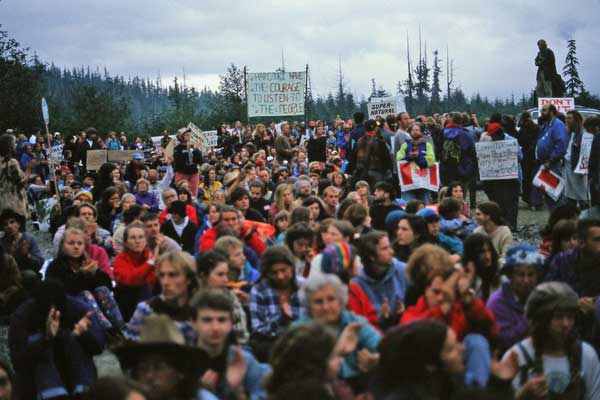
Clayoquot Sound, 1993
We won a few battles. Several coastal valleys are protected as parks. But many of them have been logged. And now the logging companies are coming back for the valleys that remain unprotected.
One of the worst corporate offenders is Teal Jones, the company currently bulldozing the majestic Walbran Valley, two hours west of Victoria, BC. They are laying waste to a vibrant rainforest for short-term profit, without the consent of the Pacheedaht First Nation, the Qwa-ba-diwa people, or anyone else outside of government and industry. Teal Jones does not even own the land; it was taken from indigenous people in the name of the BC government sixty years ago.
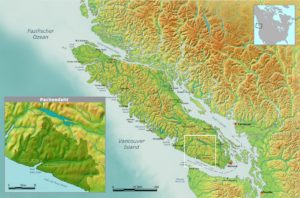
Pacheedaht territory, Vancouver Island BC
This year, the elected leadership of the Pacheedaht First Nation threw its support behind building a longhouse in the contested valley, on the land that has sustained them for countless generations. At the same time, locals are pushing back against the logging by occupying roads and logging sites. This in spite of the company’s court order telling police to arrest anyone who blocks their work. Forest defenders are regrouping, but the destruction continues.
Women for the Walbran and Forest Action Network are ramping up to break the deadlock. We’re hosting direct action trainings to share skills and develop strategies for defending ecosystems. The agenda includes tactics like non-violent civil disobedience, occupying tree-tops, and backcountry stealth. We’ll have info on legal rights, indigenous solidarity, and more.

Tree-sit occupation, Langford BC. (Photo: Ingmar Lee)
Our adversary, Teal Jones, is a relatively small company. Its owners are relying on the police to protect their “right” to strip public forests on Pacheedaht traditional territory. Profit margins are slim, and lawyers are expensive. The forest defenders are poor, but we have community support and a wide array of strategies for beating Teal Jones at its own game. Every tool in the box: we can launch a mass civil disobedience campaign, carry out hit-and-run raids on costly machines, coordinate a knockout legal strategy, or deliver the tried-and-true “death by a thousand cuts” with a combination of tactics.
However it plays out, Teal Jones is on borrowed time in the Walbran. But that’s cold comfort when the machines are mowing down thousand-year-old forests like grass.
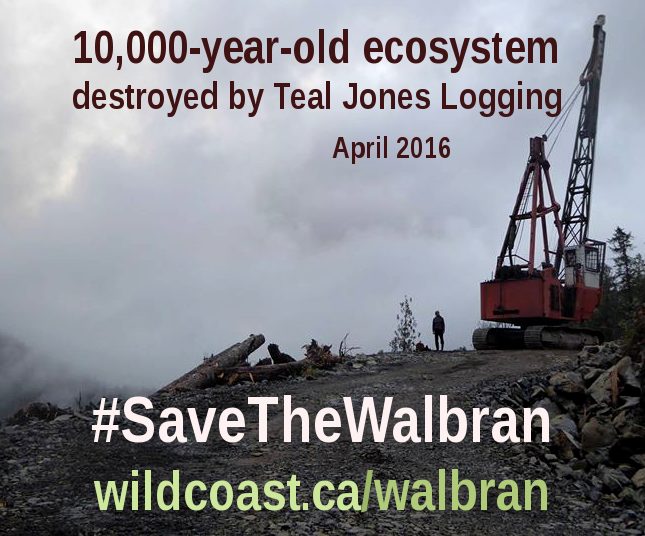
Photo: Walbran Central
The forest defenders do have certain advantages. On the practical side, we’re investing in the gear and training that will provide the leverage to win. We have a legal defense fund that’s both a war chest for litigation and a safety net for those who risk their freedom on the front lines. But our best defense is the thousands of people who love this land like life itself. Many live nearby and visit every chance they get, others came once and fell in love, and untold numbers have yet to see the Walbran’s wildlife firsthand, but they hold it in their hearts.

Photo: Walbran Central
Those who love the land are a community. We are the organizers, sponsors, and volunteers who drive this movement forward. Everyone who shares these values can be a part of it; no contribution is too small. We’re going all-out to defend the forests, rivers, bears, cougars, otters, and eagles of the Walbran Valley. They sustain us and we give back by fighting to protect them.

Walbran River, the heart of the Walbran Valley, spring 2016. (Photo: Walbran Central)
Remember: Forest Defenders Are Heroes!
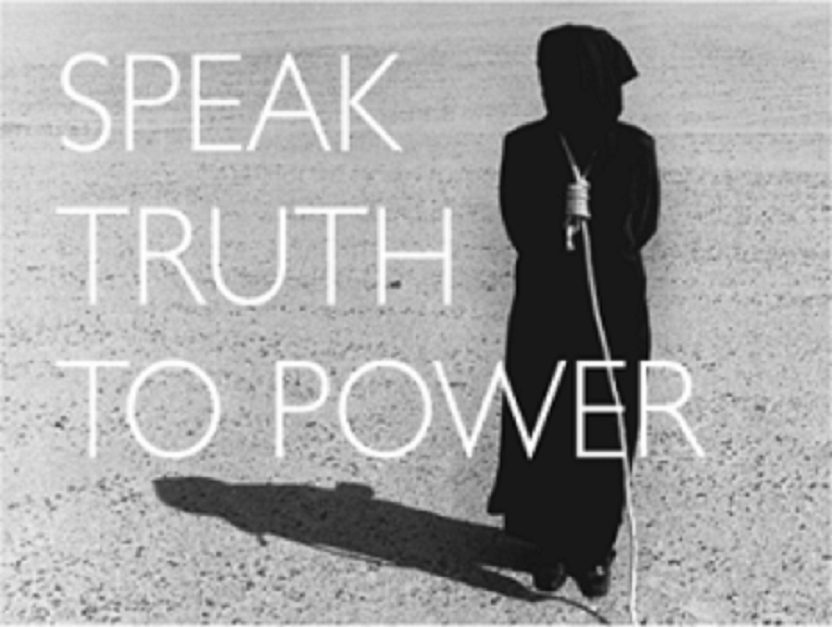
by Deep Green Resistance News Service | Jan 9, 2016 | Culture of Resistance, The Solution: Resistance
By Zoe Blunt / Deep Green Resistance
Featured Image via the Speak Truth the Power Project.
The more we challenge the status quo, the more those with power attack us. Fortunately, social change is not a popularity contest.
Activism is a path to healing from trauma. It’s taking back our power to protect ourselves and our future.
From a spoken-word presentation in Victoria BC, 2009
Thank you for the opportunity to launch my speaking career. Some of you may know me as a writer and an advocate for social and environmental justice. Others may know me as a cat-sitter, odd-jobber, and temp slave. (Laughter)
I knew when I started out as an activist that I would never be a millionaire and I was right. But I have a certain freedom and flexibility that your average millionaire might envy.
The market demand for social justice advocates is huge right now. It’s a growth industry. And the job security is fantastic – there is no shortage of urgent issues demanding our attention. Experience is not necessary, people come to activism at every age and stage in their lives. It’s that easy!
OK, it’s not actually that easy. (Laughter) But it is a fascinating time to be a “radical.”
There is a great tradition of courage and action here on Vancouver Island. There is potential for even greater future action, so we are doing everything we can to nurture that potential. Building community, linking up networks, teaching, learning, coming together, healing – this is all part of the movement.
For most of my adult life, I suffered from social phobia. I was afraid of authority, filled with self-doubt, paralyzed by anxiety. Getting interviewed live on national TV doesn’t make that go away. But hiding under the covers doesn’t cure it either. So my insecurities and I just have to get out there and do our best.
What compels me is the knowledge that we’re rewriting the script – the one that says, “You don’t make a difference. It is what it is, you can’t fight city hall, the big guys always win.” We can remember that we are not powerless. And when we choose to stand up, it is a huge adrenaline rush – bigger than national TV or swinging from a tree top. That’s the reward – that flood of excitement that comes from taking back our power and using it effectively, for the collective good.
It helps to get love letters from friends and strangers who want to thank me for standing up for what’s important, and who get inspired to take action themselves.
But it’s not all warm fuzzies and celebratory toasts. We face backlash and punishment and threats to our lives and safety.
I led a workshop for new activists this year, and I asked them, “Who are your heroes?”
They named a dozen. Gandhi. Martin Luther King. Tommy Douglas. Rosa Parks. These folks led amazing, heroic movements, but our discussion focused on the ferocious backlash they faced. British media reports on Gandhi when he was challenging the monarchy had the same tone as white Southerners responding to Rosa Parks refusing to give up her seat on the bus. It was vicious. “Uppity and no-good” were some of the polite terms. They were targeted with hate speech and death threats. We hear the same now about whistleblowers. And feminists and environmentalists. It can be terrifying.
The more we challenge the status quo, the more the entrenched powers attack us. The more effective we are, the more they attack us. As Gandhi said: “First the ignore you, then they ridicule you, then they fight you, then you win.”
The fight for justice and liberation won’t be won by popularity contests.
Every campaigner finds their own way of dealing with the counter-attacks. Some laugh it off. Some pray, some cry on their friends’ shoulders. Some go on the counter-offensive, some compose songs, some write long academic papers deconstructing their opponents’ logic. The important thing is, they deal with it, and they don’t give up.
We take care of each other as a community. Because we are all so fragile. Because there is so much trauma and despair everywhere and it affects everyone. But inside that despair, in all of us, there is a solid core of love for the earth and the knowledge that we can act in self-defense. That’s where we find strength.
It’s humbling to note that the economic downturn has done more to preserve habitat and stop climate change than all of our conservation efforts of the past years combined. We take responsibility for recycling and turning down the thermostat, but who is responsible for the scale of destruction from the Tar Sands? That project is the equivalent of burning all of Vancouver Island to the ground. It negates everything we could hope to do as individuals to fight climate change.
How do we deal with that horrible reality? I couldn’t, for the first year of the campaign. I didn’t want to look at the pictures and hear the news stories about the water and air pollution and the rates of illness among the Lubicon Cree people. The scale and the horror of it were too great.
I’ve worked on toxics campaigns and I dread them. Old-growth campaigns are inspiring, because where the action is, the forest is still standing – it’s beautiful and magical and we’re defending nature’s cathedral from the bulldozers and chainsaws. The good earth is here, and the evil destructive forces are over there. It’s clearcut, so to speak. But when a toxics campaign is underway, the damage has been done. The landscape is poisoned and people have cancer and spontaneous abortions, and the birds, the fish, the animals, are dead and dying. It is a scene of despair.
If it sounds traumatizing, it is. And we are all traumatized.
Look at this landscape – concrete, pavement, bricks and mortar, toxic chemicals, but underneath, the earth is still there. We have whole ecosystems slashed and burned without so much as a by-your-leave. We’ve lost whole communities of spruce, marmots, murrelets, arbutus, sea otters, and geoducks. These are terrible losses.
And we humans suffer on every level. Is there anyone here who doesn’t know someone who’s had cancer? Who hasn’t seen the damage caused by diseases of civilization? Who here hasn’t been forced to do without for lack of money? Are there any women here who have never been sexually harassed or raped or assaulted?
(Silence)
Something fundamental has been taken from us here. How do we deal with these losses?
I consider myself fortunate because after a lifetime of abuse from my family and male partners, I participated in six months of Trauma Recovery and Empowerment at the Battered Women’s Support Centre in Vancouver.
And I got to know the stages of trauma recovery:
Acknowledge the loss, understand the loss, grieve the loss.
And the stages of grief:
Denial, anger, bargaining, depression, and acceptance.
These steps are a natural and necessary response to the loss of a loved one, and also to the loss of our humanity and the places we love.
There are people living in national sacrifice zones, people who burn with determination to make change. They are angry, and they have a right to be. I am angry because I’m not dead inside, in spite of all they’ve done to me. Anger is part of the process of grief, and it’s useful. It grabs us by the heart when people are hurting the ones we love.
For me, part of the process is taking action – rejecting helplessness and taking back power. Stopping the bleeding and comforting the wounded.
I fall in love with places and I want to protect them. I fell in love with the Elaho Valley and some of the world’s biggest Douglas Firs in 1997. That forest campaign was a pitched battle, far from the urban centers, against one of the biggest logging companies on the coast at that time.
In the third year of the campaign, I walked into my favourite campsite shaded by majestic cedars. I saw the flagging tape and the clearcut boundaries laid out, and I realized it was all doomed. I could see the end result in my mind’s eye: stumps and slash piles as far as the eye could see, muddy wrecked creeks, a smoldering ruin.
I realized no one was going to come and save this place – not Greenpeace or the Sierra Club, no MP’s private member’s bill, or whatever petition or rally was being planned back in the city. It was as good as gone. All we had to do was stand aside and do nothing, and this incredible, irreplaceable forest would be just a sad memory.
But after that realization, and after the despair that followed, I had a profound sense of liberation. If it is all doomed, then anything we do to resist is positive, right? Anything that stops the logging, even for a minute, or slows it down, or costs the company money, or exposes it to public embarrassment and hurts its market share, is positive – it keeps the future alive for that one more minute, one more hour, one more day. It was a revelation.
Acceptance, for me, meant being able to act to defend the place I loved. It meant standing up to the bullies and refusing to let them take anything more from me.
In the third year of the Elaho campaign, it was just a handful of people rebuilding the blockades, defying the court orders and continuing the resistance. We didn’t quit when the police came, or when we were called “terrorists” and “enemies of BC.” We didn’t quit even after 100 loggers came and burned our camp to the ground and put three people in the hospital.
The attack was a horror show. People were in shock. But a crew was back with a new camp five days later. By then, the raid was national news. And our enemies had nothing left to throw at us. The loggers didn’t know what to do next. Short of killing us, what more could they do?
We had called their bluff.
We didn’t know about the negotiations going on behind the scenes. We didn’t realize that we had already cost the loggers more than they could hope to recoup by logging the entire rest of the valley. (They were operating on very slim profit margins.) We found out when the announcement came that the logging would stop. And it never started again. We won. Now the Elaho Valley is protected by the Squamish Nation — and by provincial legislation — as a Wild Spirit Place.
The violence of the mob showed the level of fear and desperation of the losing side. It was their weapon of last resort and it didn’t work. And they lost.
In the fourth year of the stand for SPAET – the campaign to stop the development and protect the caves, the garry oaks, and the wetlands on Skirt Mountain – we faced the same tactics. We were called “terrorists,” and in 2007, the developers sent 100 goons to rough up people at a small rally. And again, most of our comrades are still in shock. There’s only a handful of us still bashing away at the next phase of development.
We are winning. The other side has thrown everything they have at us and they have nothing left.
There are still sacred sites on SPAET. The cave is still there, buried under concrete.
Meanwhile, the developer’s little empire fell apart, either because of our boycott campaign, bad karma, or because it was operating on the slimmest of shady margins. We took the next phase of development to court. Our campaign, and the economic downturn, turned out to be enough to scare off investors and cancel the project, at least for now.
This work is difficult, painful, and traumatic. So the first step to courage is to acknowledge that pain and loss. We need to name what has been taken from us. Then we can cry, and rage, and grieve. We can name the ones who are doing the damage. We can reach down inside and find our core strength and our truth, and use it. That’s where courage comes from.
Martin Luther King said, “Justice shall roll down like waters, righteousness like a mighty stream.” But I’m impatient. I want to see that mighty stream now – what’s the hold-up? What’s holding us back, when there’s so much to do?
We’re not heroes, actually – none of us is smart enough, or tough enough, or connected enough, to take this on alone. We don’t have superpowers. We are only human, we struggle and suffer and sometimes, we win.
Some folks assume I have some vision, some over-arching game plan, some magic power that gives me an edge. Nope. Most of the time I am just flailing around on the political landscape, taking potshots when I see an opening. Sometimes it’s intuition, and it pays off. When we are right, it is amazing. When we win, it sets a precedent for the future.
In order for evil to prevail, all that’s required is for good people to do nothing. Don’t be one of those good people.
Activism is part of the healing. It’s taking action to protect ourselves and our future.
Thank you for the opportunity to tell these stories today.
(Applause)
Also read how Zoe Blunt moved from “flailing around on the political landscape” to strategic activism: Deep Green Resistance: Words as tactical weapons
